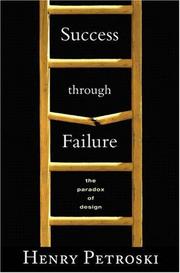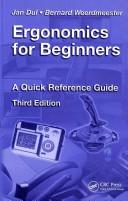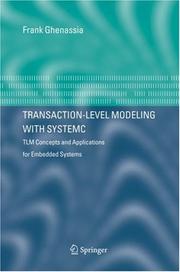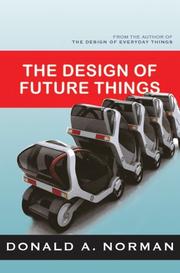| Listing 1 - 10 of 21 | << page >> |
Sort by
|
Book
ISBN: 9780136109501 0136109500 Year: 2010 Publisher: Upper Saddle River, N.J Pearson Prentice Hall
Abstract | Keywords | Export | Availability | Bookmark
 Loading...
Loading...Choose an application
- Reference Manager
- EndNote
- RefWorks (Direct export to RefWorks)
This text covers theory and industry-standard selection practices, providing students with the working knowledge to make an informed selection of materials for engineering applications and to correctly specify materials on drawings and purchasing documents. Encompassing all significant material systems-metals, ceramics, plastics, and composites-this text incorporates the most up-to-date information on material usage and availability, addresses the increasingly global nature of the field, and reflects the suggestions of numerous adopters of previous editions. For undergraduate courses in Metallurgy and Materials Science
Materials --- materialenleer --- Engineering --- Engineering materials --- Industrial materials --- Engineering design --- Manufacturing processes
Book
ISBN: 9781569904367 1569904367 Year: 2010 Publisher: München Hanser
Abstract | Keywords | Export | Availability | Bookmark
 Loading...
Loading...Choose an application
- Reference Manager
- EndNote
- RefWorks (Direct export to RefWorks)
This book assists the designer in the development of parts that are functional, reliable, manufacturable, and aesthetically pleasing. Since injection molding is the most widely used manufacturing process for the production of plastic parts, a full understanding of the integrated design process presented is essential to achieving economic and functional design goals. This book features over 425 drawings and photographs.
Engineering design. --- Injection molding of plastics. --- Machine parts. --- 678 --- Productietechnologie --- Ontwerptechnologie --- Plastics Chemical Engineering --- Industrial Engineering --- Polymers --- Kunststofverwerking --- Textiles --- Ontwerp- en productietechnologie

ISBN: 0691122253 140084911X Year: 2013 Publisher: Princeton, NJ : Princeton University Press,
Abstract | Keywords | Export | Availability | Bookmark
 Loading...
Loading...Choose an application
- Reference Manager
- EndNote
- RefWorks (Direct export to RefWorks)
Design pervades our lives. Everything from drafting a PowerPoint presentation to planning a state-of-the-art bridge embodies this universal human activity. But what makes a great design? In this compelling and wide-ranging look at the essence of invention, distinguished engineer and author Henry Petroski argues that, time and again, we have built success on the back of failure--not through easy imitation of success. Success through Failure shows us that making something better--by carefully anticipating and thus averting failure--is what invention and design are all about. Petroski explores the nature of invention and the character of the inventor through an unprecedented range of both everyday and extraordinary examples--illustrated lectures, child-resistant packaging for drugs, national constitutions, medical devices, the world's tallest skyscrapers, long-span bridges, and more. Stressing throughout that there is no surer road to eventual failure than modeling designs solely on past successes, he sheds new light on spectacular failures, from the destruction of the Tacoma Narrows Bridge in 1940 and the space shuttle disasters of recent decades, to the collapse of the World Trade Center in 2001. Petroski also looks at the prehistoric and ancient roots of many modern designs. The historical record, especially as embodied in failures, reveals patterns of human social behavior that have implications for large structures like bridges and vast organizations like NASA. Success through Failure--which will fascinate anyone intrigued by design, including engineers, architects, and designers themselves--concludes by speculating on when we can expect the next major bridge failure to occur, and the kind of bridge most likely to be involved.
Industrieel ontwerpen. --- Industriële vormgeving. --- Ontwerpen. --- Engineering design --- System failures (Engineering) --- Failure of engineering systems --- Reliability (Engineering) --- Systems engineering --- Design, Engineering --- Engineering --- Industrial design --- Strains and stresses --- Design

ISBN: 0415285208 1315375214 1420055895 1315362988 131536056X 1498785948 Year: 2006 Publisher: Boca Raton Taylor & Francis
Abstract | Keywords | Export | Availability | Bookmark
 Loading...
Loading...Choose an application
- Reference Manager
- EndNote
- RefWorks (Direct export to RefWorks)
In the 20 years, since the publication of the first edition of "Bodyspace" the knowledge base upon which ergonomics rests has increased significantly. The need for an authoritative, contemporary and, above all, usable reference is therefore great. This third edition maintains the same content and structure as previous editions, but updates the material and references to reflect recent developments in the field. The book has been substantially revised to include new research and anthropometric surveys, the latest techniques, and changes in legislation that have taken place in recent years. New coverage in the third edition includes: Guidance on design strategies and practical advice on conducting trials; overview of recent advances in simulation and digital human modes; dynamic seating; recent work on hand/handle interface; computer input devices; laptop computer use and children's use of computers; design for an aging population and accessibility for people with disabilities; and; new approaches to risk management and new assessment tools, legislation, and standards. As the previous two editions have shown, "Bodyspace" is an example of the unusual: a text that is a favourite among academics and practitioners. Losing none of the features that made previous editions so popular, the author skilfully integrates new knowledge into the existing text without sacrificing the easily accessible style that makes this book unique. More than just a reference text, this authoritative book clearly delineates the field of ergonomics.
Antropometrische ergonomie. --- Anthropometry --- Engineering design --- Human engineering --- arbeid, veiligheid --- ergonomie --- 331.015 --- anthropometrie --- interieurvormgeving --- Ergonomics --- Human factors in engineering design --- Bioengineering --- Environmental engineering --- Industrial engineering --- Human comfort --- Human-robot interaction --- Design, Engineering --- Engineering --- Industrial design --- Strains and stresses --- Skeletal remains --- Physical anthropology --- Body size --- Design

ISBN: 9781420077513 9781420077520 9781138424678 Year: 2008 Publisher: Boca Raton Taylor and Francis
Abstract | Keywords | Export | Availability | Bookmark
 Loading...
Loading...Choose an application
- Reference Manager
- EndNote
- RefWorks (Direct export to RefWorks)
1 Introduction What is ergonomics? What is an ergonomist? Social significance of ergonomics General and individual ergonomics 2 Posture and movement Biomechanical, physiological and anthropometric background Posture Movement 3 Information and operation The user Information Controls Relationship between information and operation 4 Environmental factors Noise Vibration Illumination Climate Chemical substances 5 Work organization, jobs and tasks Tasks Jobs Work organization 6 The ergonomic approach Project management 7 Sources of additional information Bibliography Useful websites Index
Ergonomie --- Human engineering. --- ergonomie --- 614.8 --- Ergonomics --- Human factors in engineering design --- Bioengineering --- Environmental engineering --- Industrial engineering --- Human comfort --- Human-robot interaction --- Accidents. Risks, hazards. Accident prevention. Personal protection. Safety --- Ergonomie. --- Human engineering
Book
ISBN: 9781569905555 156990555X 1569905568 9781569905562 Year: 2014 Publisher: Cincinnati, Ohio Hanser
Abstract | Keywords | Export | Availability | Bookmark
 Loading...
Loading...Choose an application
- Reference Manager
- EndNote
- RefWorks (Direct export to RefWorks)
"Designing Plastic Parts for Assembly" provides an excellent tool for both seasoned part designers and novices to the field, facilitating cost effective design decisions and ensuring that the plastic parts and products will stand up under use. The detailed yet simplified discussion of material selection, manufacturing techniques, and assembly procedures will enable the reader to evaluate plastic materials and to adequately design plastic parts for assembly. The book describes good joint design and implementation, the geometry and nature of the component parts, the types of load involved, and other basic information necessary in order to work successfully in this field. Throughout, the treatment is practice-oriented and focused on everyday problems and situations. The 7th edition introduces a completely new chapter on overmolding and in-mold assembly, as well as a new chapter on bonding, including accompanying examples. Laser molding and ultrasonics coverage are also brought up to date, with illustrative case histories. Contents: - Understanding Plastic Materials - Understanding Safety Factors - Strength of Materials for Plastics - Nonlinear Considerations - Assembly Techniques for Plastics - Press Fitting - Living Hinges - Snap Fitting - Bonding - In-Mold Assembly
Plastics --- Machine parts --- Engineering design --- Design, Engineering --- Engineering --- Industrial design --- Strains and stresses --- Machinery --- Parts, Machine --- Spare parts --- Casting of plastics --- Molding (Plastics) --- Plastic molding --- Molding (Chemical technology) --- Molding --- Design --- Parts

ISBN: 0139586539 9780139586538 Year: 2001 Publisher: Upper Saddle River Prentice Hall
Abstract | Keywords | Export | Availability | Bookmark
 Loading...
Loading...Choose an application
- Reference Manager
- EndNote
- RefWorks (Direct export to RefWorks)
Much has been written about the need to revitalize control education. This book addresses the problem by providing a refreshing new approach to teaching control system design. The book strongly emphasizes real-world design, making it appropriate for the first-time learner as well as for engineers in industry as a technology refresher. The book has been used by the authors for both undergraduate and graduate courses at several universities. The authors' experience is split evenly between academia and industry, which is reflected in the contents of the book. It is divided into 8 parts covering essential aspects in control, ranging from signals and systems (Bode diagrams, root locus, etc.), to SISO control (including PID and fundamental design tradeoffs), and MIMO systems (including constraints, MPC, decoupling, etc.). A key aspect of the book is the frequent use of real world design examples drawn directly from the authors' industrial experience. These are represented by over 15 substantial case studies ranging from distillation columns to satellite tracking. The book is also liberally supported by modern teaching aids available on both an accompanying CD-ROM and Companion Website. Resources to be found there include MATLAB® routines for all examples; extensive PowerPoint lecture notes based on the book; and a totally unique Java Applet-driven 'virtual laboratory' that allows readers to interact with the real-world case studies.For both undergraduate and graduate courses in Control System Design. Using a 'how to do it' approach with a strong emphasis on real-world design, this text provides comprehensive, single-source coverage of the full spectrum of control system design. Each of the text's 8 parts covers an area in control-ranging from signals and systems (Bode Diagrams, Root Locus, etc.), to SISO control (including PID and Fundamental Design Trade-Offs) and MIMO systems (including Constraints, MPC, Decoupling, etc.).
Automatic control --- System design --- Commande automatique --- Systèmes, Conception de --- System Design --- 681.51 --- 681.5.01 --- MIMO regelaars multiple input multiple output --- analoge regelaars --- digitale regeltechniek --- ontwerpen --- regeltechniek --- systeemtheorie --- toestandsruimte regelaars --- controle-apparatuur --- controlesysteem --- elektronische besturing --- mimo --- siso --- Automatic control systems in general. Technical cybernetic features --- grondslagen en theorie van besturingstechniek --- Contains audio-visual material --- Control --- Engineering Design --- Control. --- Engineering Design. --- 681.51 Automatic control systems in general. Technical cybernetic features --- Systèmes, Conception de

ISBN: 0262122634 9780262122634 Year: 2003 Publisher: Cambridge, MA M.I.T
Abstract | Keywords | Export | Availability | Bookmark
 Loading...
Loading...Choose an application
- Reference Manager
- EndNote
- RefWorks (Direct export to RefWorks)
The tools of design research, writes Brenda Laurel, will allow designers "to claim and direct the power of their profession." Often neglected in the various curricula of design schools, the new models of design research described in this book help designers to investigate people, form, and process in ways that can make their work more potent and more delightful. "At the very least," Peter Lunenfeld writes in the preface, "design research saves us from reinventing the wheel. At its best, a lively research methodology can reinvigorate the passion that so often fades after designers join the profession." The goal of the book is to introduce designers to the many research tools that can be used to inform design as well as to ideas about how and when to deploy them effectively. The chapter authors come from diverse institutions and enterprises, including Stanford University, MIT, Intel, Maxis, Studio Anybody, Sweden?s HUMlab, and Big Blue Dot. Each has something to say about how designers make themselves better at what they do through research, and illustrates it with real world examples-case studies, anecdotes, and images. Topics of this multi-voice conversation include qualitative and quantitative methods, performance ethnography and design improvisation, trend research, cultural diversity, formal and structural research practice, tactical discussions of design research process, and case studies drawn from areas as unique as computer games, museum information systems, and movies. Interspersed throughout the book are one-page "demos," snapshots of the design research experience. Design Research charts the paths from research methods to research findings to design principles to design results and demonstrates the transformation of theory into a richly satisfying and more reliably successful practice.
edited by Brenda Laurel --- grafische en reclamevormgeving --- Ontwerpen. --- Science --- Product strategy --- Architecture --- research [function] --- design [discipline] --- Methods in social research (general) --- Applied arts. Arts and crafts --- Engineering design. --- Engineering design --- 300.6 --- data-analyse --- designtheorie --- onderzoek --- onderzoeksmethoden --- onderzoeksontwerp --- 745.01 --- 766.01 --- communicatie --- design --- grafisch design --- grafische vormgeving --- grafisch ontwerp --- kunst en technologie --- productdesign --- productontwikkeling --- visuele communicatie --- Design, Engineering --- Engineering --- Industrial design --- Strains and stresses --- sociaal-wetenschappelijk onderzoek --- Design --- #SBIB:309H2812 --- Marketing, consumentengedrag, consumentisme

ISBN: 1280459611 9786610459612 0387262334 0387262326 9780387262321 1441938753 9780387262338 Year: 2005 Publisher: New York, NY : Springer US : Imprint: Springer,
Abstract | Keywords | Export | Availability | Bookmark
 Loading...
Loading...Choose an application
- Reference Manager
- EndNote
- RefWorks (Direct export to RefWorks)
Currently employed at STMicroelectronics, Transactional-Level Modeling (TLM) puts forward a novel SoC design methodology beyond RTL with measured improvements of productivity and first time silicon success. The SystemC consortium has published the official TLM development kit in May 2005 to standardize this modeling technique. The library is flexible enough to model components and systems at many different levels of abstractions: from cycle-accurate to untimed models, and from bit-true behavior to floating-point algorithms. However, careful selection of the abstraction level and associated methodology is crucial to ensure practical gains for design teams. Transaction-Level Modeling with SystemC presents the formalized abstraction and related methodology defined at STMicroelectronics, and covers all major topics related to the Electronic System-Level (ESL) industry: - TLM modeling concepts - Early embedded software development based on SoC virtual prototypes - Functional verification using reference models - Architecture analysis with mixed TLM and cycle accurate platforms - Unifying TLM and RTL with platform automation tools Complementary to the book, open source code to put this approach into practice is available on several Internet sites as indicated in the first chapter.
Systems on a chip --- Application specific integrated circuits --- C (Computer program language) --- System design. --- Design and construction. --- Design, System --- Systems design --- Electronic data processing --- System analysis --- SOC design --- Systems on chip --- Embedded computer systems --- System Design --- Design and construction --- Logische schakelingen. --- Computer engineering. --- Electronics. --- Engineering design. --- Optical materials. --- Electrical Engineering. --- Electronics and Microelectronics, Instrumentation. --- Engineering Design. --- Optical and Electronic Materials. --- Optics --- Materials --- Design, Engineering --- Engineering --- Industrial design --- Strains and stresses --- Electrical engineering --- Physical sciences --- Computers --- Design --- Electrical engineering. --- Microelectronics. --- Electronic materials. --- Electronic materials --- Microminiature electronic equipment --- Microminiaturization (Electronics) --- Electronics --- Microtechnology --- Semiconductors --- Miniature electronic equipment --- Electric engineering --- Systems on a chip - Design and construction --- Application specific integrated circuits - Design and construction

ISBN: 9780465002276 0465002277 9780465002283 0465002285 9786612460531 0465013031 0786744715 1282460536 Year: 2007 Publisher: New York Basic Books
Abstract | Keywords | Export | Availability | Bookmark
 Loading...
Loading...Choose an application
- Reference Manager
- EndNote
- RefWorks (Direct export to RefWorks)
In The Design of Future Things, best-selling author Donald A. Norman presents a revealing examination of smart technology, from smooth-talking GPS units to cantankerous refrigerators. Exploring the links between design and human psychology, he offers a consumer-oriented theory of natural human-machine interaction that can be put into practice by the engineers and industrial designers of tomorrow's thinking machines. A fascinating look at the perils and promise of the intelligent objects of the future, The Design of Future Things is a must-read for anyone interested in the dawn of a new era in technology.
Industrial design --- Human engineering --- Psychological aspects --- Human engineering. --- Psychological aspects. --- industrial design --- Product strategy --- Grafische vormgeving --- Design --- Trends --- Psychologie van de consument --- Design, Industrial --- Mechanical drawing --- New products --- Ergonomics --- Human factors in engineering design --- Bioengineering --- Environmental engineering --- Industrial engineering --- Human comfort --- Human-robot interaction --- Trend --- Consumentenpsychologie --- #SBIB:309H1730 --- Artificiële Intelligentie, knowledge engineering, --- Industrial design - Psychological aspects --- Design industriel --- Ergonomie --- Aspect psychologique
| Listing 1 - 10 of 21 | << page >> |
Sort by
|

 Search
Search Feedback
Feedback About
About Help
Help News
News